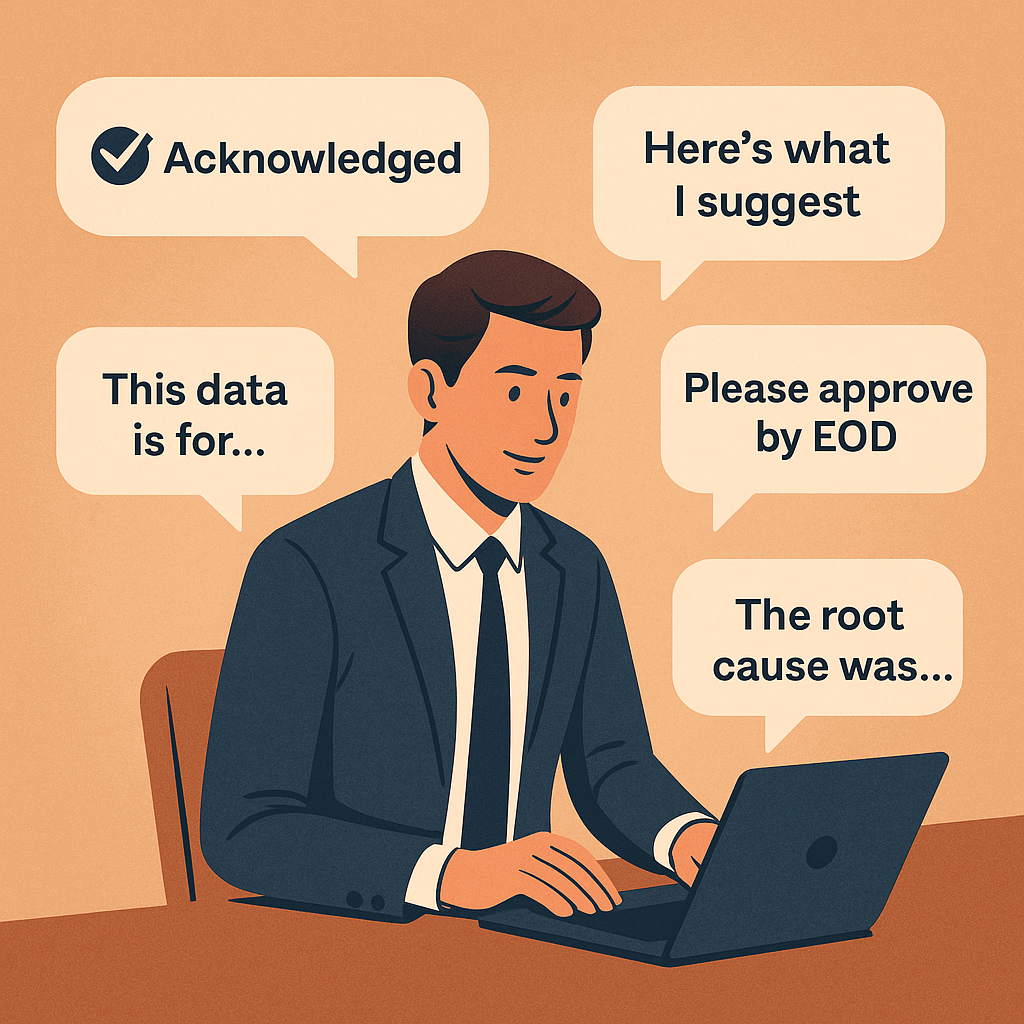The 5 Messages That Quietly Shape Your Tech Career (And No One Teaches You This)
Think your messages are just routine updates? Think again. These 5 message types silently define how you're seen — as a doer, a leader, or just noise. Mastering them early can fast-track your growth in any tech team.

No one teaches this in tech onboarding.
Not in computer science courses.
Not in Agile ceremonies.
And definitely not in bootcamps.
But the truth is — your career is shaped by the messages you write.
Not just the grand design docs or the big architecture emails.
I’m talking about the small, everyday ones:
- That Slack update after fixing a bug
- That Jira comment clarifying a requirement
- That Teams message to unblock a tester
- That escalation when something’s stuck
- That note to say “I’ve got this — I’ll check and get back”
These micro-messages signal your thinking. They reflect how you work, how you take ownership, and how well you understand both tech and people.
And when you write them with clarity and intent?
🚀 Your value becomes visible — to your team, to your leads, to the business.
Let’s break down the 5 types of messages that quietly define your reputation — and how to write them right.
💬 1. Acknowledgement Messages
“I’ve seen this — and I’m on it.”
🙅♂️ What usually happens
A request is raised. A message is sent. A bug is reported.
And… silence.
Developers often read it, understand it — but don’t respond until the work is done.
The sender is left wondering:
- Did you see it?
- Are you working on it?
- Should I ping you again?
This creates unnecessary back-and-forth, erodes trust, and delays progress — all for a problem that never really existed.
✅ How to do it right
Acknowledge early.
Even if you’re not solving it right now, let them know you’ve received it.
Examples:
- “Got it. I’ll check and update by EOD.”
- “Seen. Investigating — will update in 10.”
- “Thanks for flagging. Let me confirm the root cause and reply.”
You’re not committing to a fix — you’re committing to responsiveness.
🏢 Why it matters for the company
- Reduces unnecessary pings and meetings
- Keeps work flowing smoothly
- Signals a responsive, agile culture
👤 Why it matters for your career
- You become the person people trust to follow up
- Shows professionalism and maturity
- Positions you as a reliable teammate and future lead
📌 Responsiveness is not equal to availability. It’s just basic respect.
🧠 2. Audience-Aligned Messaging
"Does this make sense to them?"
🙅♂️ What usually happens
We write Jira comments or Slack updates like we’re talking to another developer.
“Fixed Redis flag override. Retry queue operational.”
But what if the reader is:
- A QA analyst?
- A support engineer?
- A business stakeholder?
They don’t speak that language. And when they’re confused, delays happen.
✅ How to do it right
Tailor your message to who’s reading it.
Ask yourself: “If I were them, what would I want to know?”
Instead of:
“Issue resolved. Flag now set true.”
Say:
“Customers can now resubmit failed orders. The system will auto-retry and confirm.”
Bonus trick: Add a “What this means for you” line.
Example:
“What this means for you: You can now test the failed scenarios. They should pass without retries.”
🏢 Why it matters for the company
- Reduces ambiguity and follow-ups
- Makes communication faster across functions
- Builds clarity into every layer of delivery
👤 Why it matters for your career
- You stand out as someone who communicates across roles
- Shows empathy, not just expertise
- Prepares you for cross-functional leadership roles
📌 If your message isn’t understood, it might as well not exist.
✅ 3. Clarity Confirmation Messages
"Here’s what I understood. Am I right?"
🙅♂️ What usually happens
You attend a requirement call.
They say: “We want to change how reports are handled.”
You assume “reports” means the report module.
But they were talking about a data export screen.
You go build something else.
2 days of work, gone.
Misalignment wasn’t because of skill — it was because of not clarifying assumptions.
✅ How to do it right
Repeat what you understood. Out loud or in writing.
Example:
“So just to confirm — when you say 'report', you’re referring to the daily export from the dashboard, not the analytics module. Correct?”
The moment you try repeating it, your own gaps show up. That’s your signal to ask.
🏢 Why it matters for the company
- Saves days (and $$$) of rework
- Keeps tech aligned with business intent
- Builds a proactive culture of double-checking
👤 Why it matters for your career
- Shows maturity and presence of mind
- Reduces costly misunderstandings
- Makes you the person who builds the right thing — not just anything
📌 Clarity is not assumed. It’s confirmed.
📈 4. Status + Progress Updates
“Here’s what’s done, what’s pending, and what I need from you.”
🙅♂️ What usually happens
Updates are vague. Messages like:
“Working on it.”
“Almost done.”
“Should be fine now.”
Result? Nobody knows:
- What changed?
- Can we test?
- Can we release?
These gaps lead to delays, confusion, and sometimes — escalations.
✅ How to do it right
Use the What–Why–Next model:
“Updated retry logic for file uploads (what). Previous version didn’t handle partial failures (why). Please retest today before 3 PM so we can push to staging (next).”
OR
Use Head–Heart–Hand–Leg:
- Head (Point): What’s the core update?
- Heart (Why): Why does it matter?
- Hand (Proof): What evidence backs it?
- Leg (Action): What’s the next step or ask?
This turns your update into a mini project alignment message.
🏢 Why it matters for the company
- Projects move forward without blockers
- Everyone stays informed without micro-management
- Issues are surfaced before they explode
👤 Why it matters for your career
- Builds visibility — people see your contribution
- Positions you as someone who owns outcomes
- Makes you ready for lead and PM-facing roles
📌 Don’t make people guess what’s done. Tell them — clearly, and completely.
🚨 5. Escalation + Ownership Messages
“Here’s the blocker — and here’s what we can do.”
🙅♂️ What usually happens
Blockers arise.
We either:
- Stay silent, hoping it’ll resolve
- Escalate — but with blame, or confusion
- Throw the issue over the fence
This makes teams defensive. Or worse — stuck.
✅ How to do it right
Escalate with structured ownership:
“The file from Vendor A is missing headers. We’ve reached out. Meanwhile, should we process what’s valid and send partial report — or wait?”
This message has:
- Clear problem
- Root cause
- Steps already taken
- Options being explored
- A decision needed
Escalations like this invite action, not emotion.
🏢 Why it matters for the company
- Unblocks work faster
- Avoids blame culture
- Builds a problem-solving mindset across teams
👤 Why it matters for your career
- You’re seen as someone who raises issues responsibly
- You build influence — without conflict
- Leadership starts trusting you with bigger decisions
📌 Raising a problem is easy. Showing ownership in how you raise it — that’s rare.
🧭 Final Thoughts
You write dozens of messages every week — in Slack, Jira, Outlook, Teams.
But very few realize:
These are not just updates.
These are signals of how you think.
How you:
- Process problems
- Collaborate with people
- Take ownership
- Drive outcomes
📌 That’s what defines your value in tech.
And the best part?
You don’t need to be a great writer.
You just need to think clearly, and write intentionally.
Every message is an opportunity.
To clarify. To lead. To grow.
💡 Try This Today
Start with just one.
This week, focus on 1 of these message types — maybe it’s status updates.
Apply the structure. Add the clarity. Invite action.
And then watch:
- Fewer follow-ups
- Better alignment
- Faster movement
- And slowly… more trust in you
Because the way you write?
That’s how people experience your thinking.
💬 Let’s Connect
Enjoyed this article or have a perspective to share? Let’s connect on LinkedIn.

